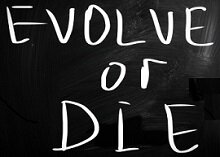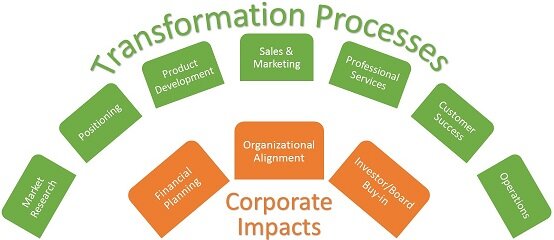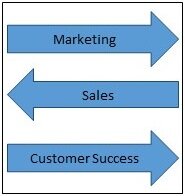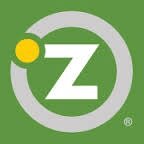 Customers are shifting from purchase software to SaaS subscriptions. They want the flexibility of only spending money for what they need, when they need it, with the advantages of having the most current offerings. They don’t want to be locked into the “stuff they own.”
Customers are shifting from purchase software to SaaS subscriptions. They want the flexibility of only spending money for what they need, when they need it, with the advantages of having the most current offerings. They don’t want to be locked into the “stuff they own.”
They stream Spotify or Apple Music; they don’t buy it on iTunes; they use Uber instead of their own car; and they use Salesforce, not Oracle Siebel.
Software vendors are following customer demand by transitioning from a product sale to a SaaS subscription offering – that’s where the growth is. In 2017 Public SaaS vendors grow at a median rate of 28% versus 12% for Software vendors.
The transition of software vendors to a SaaS model impacts every aspect of the company, whether selling a digital or physical item. The complexity of moving to a SaaS subscription model is substantial, but a stepwise approach makes it feasible with impressive results.
This article walks through the steps of this transformation for an entire company or a single line-of-business.
The Choices for Vendors “In Transition” to SaaS
Adobe subscription revenue increased from 25% to 53% in the year following their switch of their Creative Cloud to a subscription model in April 2013, one of the most rapid product transition from a software purchase to a subscription license of any major software product.
Their stock price nearly doubled in the same period even with lower revenue and profits.
The most important decision in the move to a SaaS model is to get going. The move to SaaS will be an ongoing process impacting all parts of the organization, but can be a stepwise process. Large vendors will transition product line by product line over a number of years.
Software vendors moving towards a SaaS model can add new SaaS offerings, which do not compete with the company’s “for sale” without risk to existing revenue streams. The product company may decide to offer both comparable purchased and SaaS offerings. Generally, the company will ultimately withdraw its purchased products, but this can be a challenge for successful product vendors, its customers, and its partners.
The speed of the transition of software vendor from purchased products to SaaS offering is a key management decision. Vendors that protect their purchased products from competition from their SaaS services rarely success in creating a best-of-breed SaaS offering; There are few examples of vendors that are leaders with both purchased and SaaS offerings.
The Process of the SaaS Transformation
There are seven major facets in the transformation to a SaaS model. Additionally, there are corporate-wide implications in understanding the financial changes, making organizational changes, and “selling” boards and investors on the transition.
 The initial SaaS offering will not be the perfect product, but if the customer experience is good, some short cuts can be taken to create a SaaS offering in an expedited timeframe to avoid being left behind as the market shifts.
The initial SaaS offering will not be the perfect product, but if the customer experience is good, some short cuts can be taken to create a SaaS offering in an expedited timeframe to avoid being left behind as the market shifts.
Each organization within the company must focus on their responsibility to create, market, and support the new SaaS offering.
The steps to the SaaS transformation are outlined below:
Market Research
Like any new offering, the Total Available Market (TAM) should be determined. The SaaS aspect of the offering is an important distinction in attacking new markets. The majority of markets now have both products purchased and SaaS offerings. SaaS offerings generally have much higher growth – their market opportunity will increase over time. For example, medical records software has rapidly shifted to SaaS just as CRM shifted to SaaS. Markets do not remain static.
The market research will identify both legacy software vendors as well as other SaaS offerings. Market research identifying these competitors and their strengths and weaknesses is essential.
The move will entail rethinking the strategic partners in creating the “whole product” which relies on other vendors’ products and services. The market research should also identify partners who can assist in the transition to SaaS and jointly help serve the customers’ needs.
Product Definition/Positioning
The only thing that matters is getting to product/market fit.
Product/market fit means being in a good market with a product that can satisfy that market.
— Marc Andreessen
Once the market is understood, the specific product offering must be defined.
At the most basic level, the SaaS offering can be the current product offering delivered as SaaS with recurring subscription billing. For over a decade, product vendors have worked with Managed Service Providers (MSPs) to host products as a service to customers who haven’t wanted the complexity of managing the product operation. The use of MSPs can provide an accelerated entry into SaaS delivery of a digital service, but is only a stepping-stone to a long-term solution.
A company can repackage its current products itself and offer them through SaaS. This can be a viable way to quickly create a SaaS offering, but will likely not be “best-in-class” offering.
Many SaaS offerings have market success not only because they are SaaS based, but also because they use are free to use the most advanced technology without a legacy of old products owned by customers to support. It is difficult and time-consuming to keep multiple versions of products current which are owned by their customers.
The move to a SaaS offering is the ideal time to plan a long-term strategy based on improving the User Experience (UX) mirroring the experience users expect from their consumer applications, adding new capabilities such as mobile or social offerings and providing additional functionality. The ability to customize the experience to the needs of the user is also expected in modern SaaS offerings.
Critically, the product company must move to reposition itself as a SaaS leader. Some product vendors move to SaaS is touted on their website, but not reflected in their products and their company DNA. Vendors should move aggressively in SaaS leadership to compete with pure-play SaaS vendors. When customers decide that a SaaS solution is a mandatory requirement, they will only consider products from vendors that are “all-in” the SaaS model without compromise compared to a company’s purchased products.
Product Development
The minimal viable SaaS product may only be a repackaging of a product offered for sale now offered as a service, but will ultimately require major architectural changes to be “world-class.”
Mandatory Product Development and DevOps Capabilities Prior to Customer Release:
- Hosting and system management
- User on-boarding processes
- Billing and pricing systems with usage measurement
- Security and regulatory compliance
- Software upgrade procedures
- System monitoring, including performance and availability
- Disaster Recovery
After the initial product launch, the development work continues to optimize the user experience, reduce the cost of providing the SaaS service, and to monitor the customer engagement to minimize churn and increase up-selling into the customer base.
Optimized Product and DevOps Capabilities:
- Cost of Service Reductions:
- Full multi-tenancy architecture
- Software efficiency improvements
- Optimized scaling and efficient utilization of compute resources
- Operations automation
Best practices for reducing the cost of SaaS operations are described in the article The Imperative to Reduce the Cost of SaaS Services.
- User Experience
- Improved and more intuitive User Interfaces
- Enhanced customization tailored to the user’s capabilities
- Improved help and self-directed learning
- Responsive user interface designs tailored to the user’s device
- Mobile apps
Many legacy software products have dated user interfaces, which should be replaced by modern mobile app and browser-based user interfaces. Think Facebook, not old-style ERP.
- Customer Engagement Analytics
- Monitor how the service is used by each user
- Identify problems with initial onboarding and take action to improve early use
- Identify low usage of key features to identify and take action on potential churn
- Improve the product by examining actual use
- Improve the success of customer using the service by targeting assistance based on use
- Identify up-sell prospects based on system usage
SaaS capabilities provide unique insights into how these offerings are used that is impossible with products that were installed and used within the customers’ facility. This “engagement” data is essential for ensuring “Customer Success,” optimizing their use of the system, and maximizing the revenue from SaaS customers.
Sales and Marketing

Priorities shift with SaaS
Sales and Marketing plans need to be rethought for SaaS offerings.
Sales interaction, while crucial, occurs later in the customer acquisition process. Customer Success becomes a key factor in revenue generation due to the extreme importance of customer retention, the company’s reputation which drives referrals, and the ability to drive up-sales into the customer base.There tends to be more of an emphasis on marketing versus sales in SaaS vendors. Prospects are more likely to do their own product research before their first contact with the SaaS vendor.
SaaS Marketing Best Practices:
- Emphasize a Content Marketing Strategy to ensure you build brand awareness and reputation prior to the first contact
- Make it easy for prospects to try your product both through free trial programs
- Ensure the success of the trial by ease of on-boarding and assistance trials
- Monitor and foster the social “buzz” around the SaaS offering by actively participating in and promoting the social discussion
- Build user communities to drive customer success, up-sales, and referrals
Strategies for Vendors with “Competing” Purchased & SaaS Offerings:
Offering both purchased and SaaS offerings is a common transitional strategy, but the company should move towards a pure-play SaaS offering rather than having a foot in both camps indefinitely.
Vendors transitioning to a SaaS model often offer similar products both as a product purchase and a SaaS . This is usually a transitional strategy. The ratio of the customer’s costs of product purchase to yearly SaaS cost is approximately three to one. The ratio may decrease to incent legacy customers to migrate to SaaS models.
Some vendors with legacy purchased products offer low-end SaaS services with a subset of capabilities of their purchased products. This low-end SaaS offering strategy rarely competes well against competitive offerings. The successful SaaS vendor should move quickly to provide a full set of capabilities without restricting the success of the SaaS offering.
Sales Strategies
SaaS sales to the enterprise tend to be smaller since the customer often will use the software in one area of the company, and then expand use with their success. This will result in higher sales expense for the initial SaaS offering to a strategic account, with lower sales expenses for future sales.
SaaS vendors should closely monitor their “Growth Efficiency Index” (GEI) – the cost of new revenue divided by the new Annual Recurring Revenue (ARR). The cost of add-on revenue from an existing customer should be much less than the cost of the initial revenue.
With a lower initial revenue and cash from the initial sale, sales and marketing costs must be optimized. The reduced customer lock-in and the ability to try the product before committing to its long-term use reduces the sales time. “Proof of Concept” (POC) trials before purchase are being replaced with free trials with minimal up-front investment prior to its use.
SaaS customers will expect a “lower-touch” sales effort with their greater personal market research and access to online resources not requiring direct sales interaction.
Sales compensation for SaaS sales should ensure the sales person’s compensation aligns with the company’s goals. The majority of the sales compensation should be front-loaded so the sales person is paid primarily for the initial new ARR sold. If a salesperson sells both purchased and SaaS offerings, the compensation package should be structured so the cash flow from both sales is similar.
Pricing Strategies
SaaS offerings allow much greater flexibly in pricing structure that aligns the cost of the offering to the value received. In addition to traditional, “per-seat” pricing, SaaS models allow the ability to charge based on usage. SaaS vendors should ensure they have a billing engine designed for subscription billing that both allows them to change pricing models (such as per seat versus usage based billing) while provide advanced reporting, and operational efficiencies.
Both B2B SaaS vendors should require pre-payment of the first year of the service. Larger, multi-year prepayment options should be considered with additional discounts.
Partnering Strategies
The move to SaaS has a major impact on a company’s Value Added Resellers and System Integrators as discussed in the article, SaaS Now Revolutionizes the Channel. Some partners will embrace the move to SaaS to grow more rapidly with the subscription economy. Others may be reluctant to make the transition because of the potential impact on their near-term cash flow and professional services. The forward-thinking partners will embrace the long-term benefits of the SaaS model – those that don’t or can’t, should be phased out and replaced with new partners eager to capitalize on the SaaS model.
Professional Services
The services required to implement a B2B SaaS offering are different than a product sale. When a SaaS offering is hosted by the SaaS vendor, the professional services are much less than required to install a product on customer premises. SaaS offerings often are typically more configurable than products which are owned by the customer since these offerings must work for many different customer’s configurations, not modified for each customer as was common in large software products.
These decreases in effort in installation and customization are offset by greater integration with other products more common in SaaS offerings. These are the functions that add significant incremental value to their customers.
Customer Success
SaaS businesses must have a greater focus on customer success to prosper, but they have a closer relationship with making it more feasible to ensure their customer’s success.
Since SaaS customers aren’t “locked-in,” their success is required for their retention and expansion.
- If customers are not getting value, they will terminate their SaaS causing the dreaded “churn.”
- Most successful SaaS vendors gain their greatest profits from incremental sales within their existing customer base. This requires the satisfied customers, getting real benefits for the SaaS offering.
- With social media, the success or failure of each customer is magnified into the pool of potential prospects. The success of the customer base is essential for building a positive reputation for the SaaS vendor and obtain referrals for new customers.
Fortunately, SaaS vendors have unique insights into the usage of their products by their customers since the company can monitor their customer’s usage levels of digital products in real time – usage is highly correlated with customer success. Customer engagement analytics provides visibility allows the SaaS vendor to monitor the activity levels of each customer and take steps to ensure proactive steps to improve the success of their customer from on-boarding to production use with insight from their usage levels.
Customer Engagement Analytics used to empower Customer Success programs should be initiated as soon as feasible following the launch of a new SaaS offering.
Operations
The operations of the SaaS business is essential to customer satisfaction and company profitability.
Initial SaaS offerings will have high percent operating cost prior to optimization. The cost of providing the SaaS offering should decline to under 20% of the SaaS revenue as the service delivery is optimized. These optimization steps will include both through development changes to enhance the hosting resource efficiency as well as the automation of the system administration and operation. SaaS offerings should strive to reduce operational costs, including support below 20% of the SaaS revenue as described in the article The Imperative of Reducing the Cost of SaaS Services.
The SaaS operations must be flexible to support rapid growth. As business expands (or contracts seasonally), SaaS operations must be positioned to respond quickly through automation. SaaS operations should never be a barrier for the rapid changes in new SaaS offerings or changes in pricing or pricing methods. This requires an operations infrastructure design for change.
COMPANY-WIDE IMPACTS
In addition to each functional area, the transformation to a SaaS model will have a significant impact on the company as a whole.
Financial Planning
The transition to a SaaS model will significantly impact the company’s P&L, cash flow, and its cash requirements. The transition of a purchased to a SaaS model will decrease the cash flow and negatively impact the P&L for several years until the cumulative SaaS revenue stream exceeds the revenue from product sales. The greater the growth, the greater the impact on short-term profits. The cash flow impact can be reduced by requiring larger prepayment of B2B subscriptions.
The near-term reduction in the profitability and cash flow should be modeled to determine the cash required to fund the transition to SaaS .
Product changes will need to be funded to modernize or rewrite existing digital products and their delivery mechanism, and well as making them more efficient in their use of computing resources to reduce the cost of providing the service.
The cash requirements of the deferred cash flow and additional development task, in addition to potential additional marketing expenses to accelerate growth must be forecasted and funded.
The result of the transformation will, based on the median valuation of public SaaS vendors over double the price/revenue ratios of the SaaS company.
Investor/Board Buy-in
Investors and boards have become more sophisticated in understanding the costs and benefits of moving to a SaaS model. While investors understand there will be both a near-term profitability and revenue impact, accepting this business disruption is a major decision for company management and their board.
The first step is to make sure boards and investors understand the changes in the business model and the effects that will have to the company’s near term finances. Developing a thorough business model with both the organizational plan as described in the sections above and the forecast financials through the transition is imperative. Secondarily, establishing key metrics to track progress and to quantifiably monitor the progress against industry benchmarks will both help give the plan credibility and provide a roadmap to assess the performance of the company as it moves to a SaaS model.
The financial analysis of SaaS vendors is described in the article, How’s Your SaaS Business Performing? which describes the key metrics and financial measures for a SaaS business.
Early leaders in transitioning from purchased products to SaaS such as Adobe have led the way in educating the financial markets in the expected impacts and benefits of the transition.
Organizational Impacts
Management needs to understand that the shift to a SaaS model has impacts on all aspects of the company:
- Customer relations shift focus from closing deals to establishing long-term relationships
- A renewed focus on Customer Success to provide enduring value from merely fixing problems which are broken from customer support
- Compensation models need to change to shift from closing large deals to building customer relationships and deriving more value for the customer and the company.
- Product development should shift from a “big bang” product delivery cycle to continuous release practices enabled by providing the current product “as-a-service” without the need to support many different product versions at each customer site. This change to a continuous delivery of new capabilities will substantially change the way products are released and supported.
Just as the company shifts its processes with a move to SaaS , it should ensure it employees and partners are aligned with these changes. This requires education of the SaaS best practices and explaining the benefits of the new model.
CONCLUSIONS
The move to a SaaS-based model for a product company requires a major change in the company DNA. The benefits are great, and the vendors that get in front of sea-changes in their industry will thrive. Vendors that are slow to the move to SaaS have seen their company value and growth decline.
Progressive vendors are moving aggressively to the SaaS model with impressive results. It is imperative to plan the transition through all areas within the company, its partners, its investors, and its customers. Education of each of the constituents in the company’s ecosystem is critical to demonstrate the benefits and the best practices for making the transition. It is imperative to monitor the progression with the appropriate metrics and to make corrections as necessary.
The most important aspect is to begin the transition with a SaaS offering in at least one part of the company. There is a great deal of company learning as well as changing of the corporate culture in this transformation. The sooner the efforts begin, the sooner the payoff will occur.
Sponsored by Zuora




